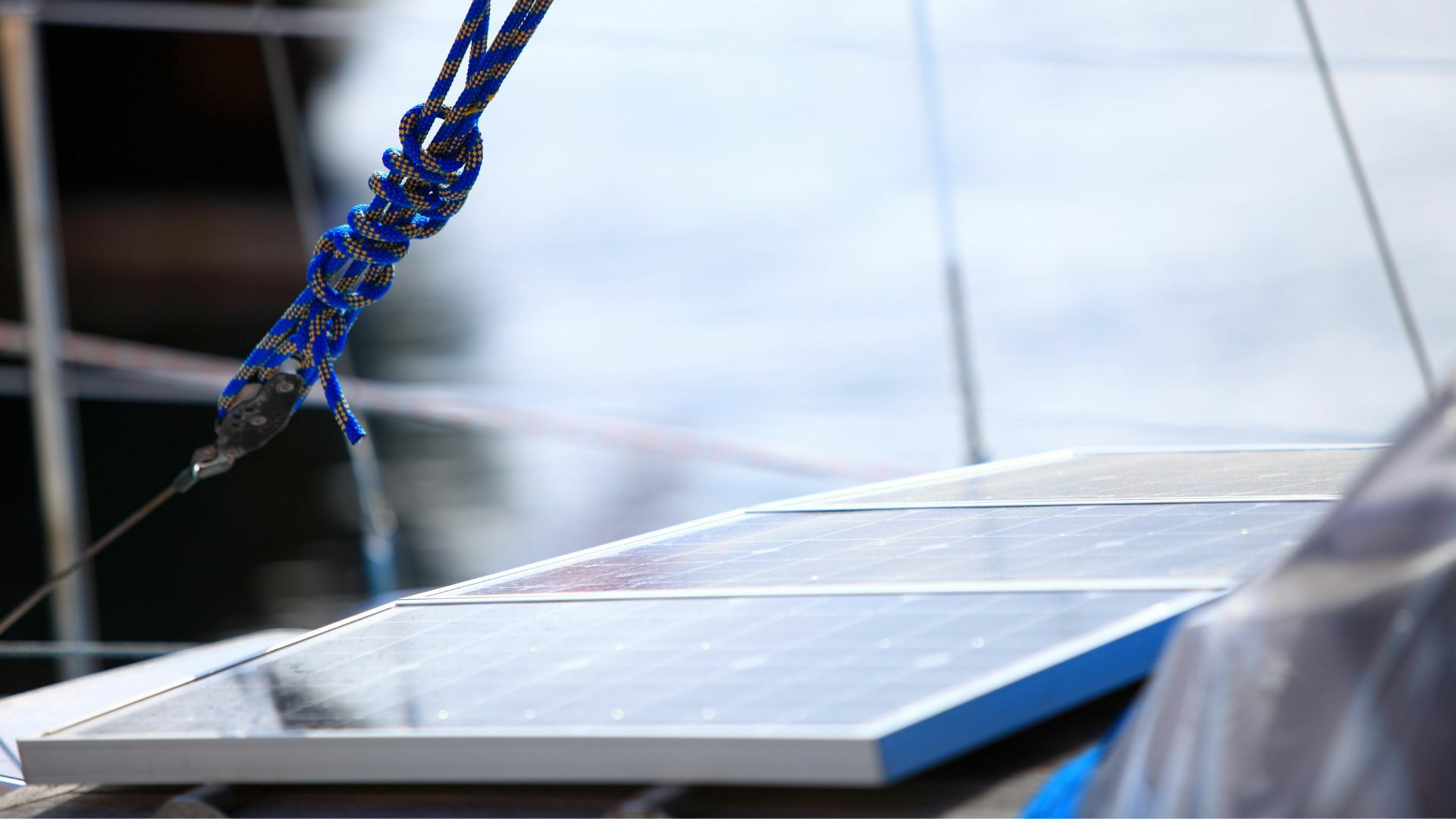I thought I would share my experience with lithium battery power to help other sailboat cruisers evaluate and decide whether taking the plunge with LifePO4 batteries makes sense for them. I purchased and installed a REliON lithium iron phosphate battery in 2019 on my cruising sailboat. I am not sponsored by any of the product makers that I reference and I do not work in the marine industry. So here we go…
I am a long-distance sailboat cruiser with a home base in New Bern, NC. I am almost always a single-hander since my better half prefers solid land. I cruise the coastal sounds and waters of North Carolina as well as the coastal waters of the southeast US and the Bahamas. I prefer to do my installation and repairs based on the theory that I know how things are installed on my vessel and I know how to fix something that needs attention. Yes, I have had many redos over the years, but I learn fast from my mistakes and I am willing to share my successes and failures with other cruisers.
Switching Up My Sailboat To LiFePO4 Batteries
I sail on an Endeavour 32 sailboat so I am not on one of these big sailboats or catamarans with lots of room. I have to smartly use every inch of space and I have limited space for a house battery bank. 2017 was my first trip down the East Coast to the Bahamas. It was a seven-month adventure. I left with two brand new 6-volt lead batteries (230 amp hours) as the house bank. That was the battery system setup on the boat when I bought it in 2009 and it seemed to work fine. I like to keep things simple so my biggest power draw is refrigeration. My charging setup at the time was a 130-watt solar panel wired to the house batteries, a separate starting battery wired to the engine alternator, and a Yandina 100 battery combiner. The purpose of the combiner is to provide a way to charge the house battery bank from the engine alternator through the starting battery when the engine is running and NOT have to remember to manually turn a battery combiner switch on and off.
The power system worked fine on the way down to the Bahamas. Since I was ducking in and out of the ICW going south, and I made weekly overnight marina stops, there were frequent periods when the engine was running or I was plugged into shore power, so the house batteries were getting a regular full charge. Issues started to arise once in the Bahamas. There was much more sailing and much less motoring and marina time. Since the engine was not running much the solar panel was the main charging source for the house batteries. Lead-based batteries like to be fully charged regularly. Plus, lead-based batteries can take a full-throttle bulk charge up to about 80-85% charged, then the charge input drops off for that last 15-20% and it can take much longer to complete that last bit of charging with solar. So, the house batteries were not getting fully charged regularly. A larger solar array would have helped, but space and cost were factors.
After four months of cruising the Bahamas it was time to start the return voyage back to the U.S. I could tell that the house batteries were no longer able to hold a full charge even if the engine had been running for a while. They seemed to be able to hold about a 70% charge. My entry point back into the U.S. was Ft Pierce, Florida and one of my first tasks was to get two new 6-volt batteries. I considered this a temporary fix to get back home, but I needed a better long-term fix.
Once back home, I started researching lithium batteries for sailboats. I wanted the easiest path forward that did not require a lot of re-engineering but was also safe and reliable. I read all kinds of warnings about LifePO4 batteries frying older alternators, that LifePO4 batteries are not a drop-in replacement, and you needed to install a new alternator and a smart regulator. I came across several good sources of information that explained how and why a LifePO4 battery with a built-in battery management system (BMS) will switch off charging when the battery is fully charged and an alternator can get cooked with a sudden huge voltage surge when that happens. Some of those sources also pointed to an easy solution – have the alternator charge a separate lead-based starting battery and use a battery combiner to allow for the starting battery to dump a charge to the lithium battery when the engine is running. Since the alternator charge is going to a lead-based battery it never has to deal with what a lithium battery’s BMS is doing. Wait a minute... I already had that setup! It seemed like an easy path to transition to a lithium house battery bank.

Installing RELiON Batteries In My Sailboat
I did a lot of research on lithium battery manufacturers. There was an overwhelming number of providers. I narrowed it down to what seemed to be a short list of solid top-shelf companies with marine battery experience. “Gone with the Wynns” YouTube channel did a video on their installation of RELiON batteries on their catamaran and that was the confirmation I needed to go with RELiON. I ordered a 200 amp hour battery to replace my house battery bank. My purchase was nothing more than a tiny blip on RELiON’s bottom line, but ordering was easy and I received the battery in a timely fashion. It had to be shipped as truck freight, but it made it to my house unscathed.
I made a few changes to my existing charging system to make things as “lithium” friendly as possible. I switched out the solar panel charge controller to one specifically designed for lithium batteries. I switched out the Yandina combiner for one of their lithium-specific combiners. I also added a battery monitor so that I could better track solar panel output and charging. I left the lead-based starting battery in place. Lithium battery installation was pretty much a swap-out effort – exactly what I was shooting for.
How My RELiON Battery Performed For Sailing
I can’t guarantee that my lithium battery installation and configuration would be the AYBC way to do this, but it has been bulletproof, reliable, trouble-free, and safe for the past four years. A second trip to the Bahamas in 2021 stress-tested my house power system and it performed flawlessly. The only problem I ran into was my five-year-old lead-based starting battery died on the way to Florida and I had to replace it.
The lithium battery has been a game changer for cruising. By far, the biggest advantage of a lithium battery has been the charging behavior. With lead-based house batteries, you are hauling around a big chunk of amp hours that you can’t use. Lead batteries don’t like to go below 50% charge and they like to be fully charged regularly. I found it tough to get to full charge on the lead-based house batteries in a day with my solar panel. A lithium battery doesn’t care if it is fully charged or 70% charged. If it is overcast and I don’t get to full charge, even over a few days, then it is no problem for the lithium battery. Only a few times have I drawn down the lithium battery below 50% charge, but I know that I can safely go way below 50% charge if necessary. Plus, the voltage stays constant as the amp hours go down – no dimming of lights and no dragging of bilge and water pumps.
Solar charging is significantly more efficient with a lithium battery. With my lead-based house battery bank, the solar panel controller would output a maximum of 5-6 amps until the battery bank hit the 80% charge level; it could get to this point pretty quickly. Then it would dial back the charging output to around 2 amps. When I installed the lithium battery, one of the first things I noticed was the solar panel controller was outputting a maximum of 7-8 amps. The lithium battery was taking whatever charge the solar panel could produce up to the point when it was fully charged. The limiting factor is no longer the battery’s ability to absorb the charge; it is the amount of sunlight available to generate power. I have found that my solar panel can now easily get the house battery to full charge by early afternoon even on a partly cloudy day.

While not a game changer, weight and location were significant factors related to switching out batteries. The two lead-based house batteries weighed over 60 pounds each, over 120 pounds in total. They were tough to wrestle in and out of a cramped battery compartment. Plus, I had to regularly check battery fluid levels in a tight space. The single 200 amp hour lithium battery weighs around 60 pounds and it requires no fluid maintenance. I occasionally check battery cables and tie-downs, but that is all the “maintenance” that I have to do.
A Few Gotchas
I encountered a few glitches that have nothing to do with the RELiON battery itself, but I am including them so that others have complete information on my approach. They are not huge or dangerous issues but more like annoyances.
The first issue has to do with the battery monitor. The battery monitor is attached to the lithium house battery, specifically, between the negative battery cable and the negative battery post. If the engine is running and the battery combiner is allowing charge from the alternator/starting battery to go to the house battery, that charge input is invisible to the battery monitor. If I have been motoring for some time and the battery monitor shows around 14.2 voltage then I know the house battery is fully charged and I have to remember to manually reset the battery monitor to “fully charged”.
The second issue has to do with the battery combiner. When the lithium battery reaches full charge its BMS turns off charge input. The battery combiner does not know how to handle this and it starts making a squawking noise. Fortunately, the combiner has a special wire where you can easily add a switch to manually turn off the combine state.
Again, neither of these issues is related to the RELiON battery and could probably be resolved with a more sophisticated battery combiner and battery monitor setup.
Final Comments
If you are doing, or going to be doing, long-distance cruising on a sailboat over extended periods where you are going to be anchoring out, and sailing instead of motoring, I would strongly recommend that you install LifePO4 batteries for the house power system. It makes even more sense on a smaller sailboat with limited space. The flexibility, reliability, and near-zero maintenance are worth it. Solar charging becomes much more efficient. Depending on your current power system configuration, the transition can be done cost-effectively without having to do a lot of re-engineering.
RELiON makes a great battery that I have found to be trouble-free rock-solid reliable in the marine environment. When I purchased the battery in 2019 it was around $2,500. The price has dropped to around $1,700 today. The investment has been worth every penny.
Have questions? Contact the RELiON team about how to upgrade your sailboat to lithium batteries.
About The Writer:
Greetings. I purchased one of your 200 ah batteries for a small cruising sailboat to replace lead acid house batteries. I put together some notes on my installation and experiences with LiFo batteries that I share with boater friends and other cruisers thinking about making the switch, so that they can understand my approach.
- Tim T | North Carolina Boater
